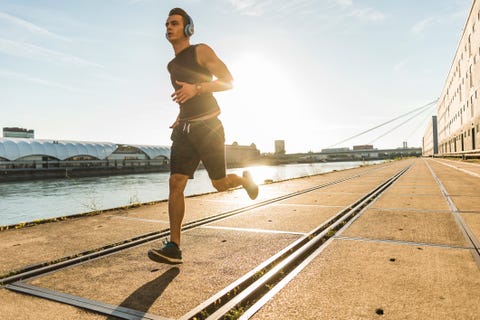
There’s a debate brewing across America right now: to run or not to run?
A new computer simulation showing how droplets from exhalations, coughs, and sneezes can spread while running has gone viral—and caused further debate about whether it’s safe to jog in parks.
The video, produced by a team of Dutch and Belgium researchers, shows that running behind someone could put you at risk for COVID-19 because droplets fly back in the slipstream, or the zone directly behind the person in front of you. The implication is that anyone unlucky enough to enter that area would possibly inhale the droplets, then potentially be exposed to the disease.
(1/2) #COVID19 #SocialDistancing when walking/running/#cycling nearby non-family members. Summary in @hbvl & @HLN_BE. Message: keep exercising but stay outside slipstreams. Movie below: for walking.
Research @TUeindhoven @LeuvenU @ansys #CFD #aerodynamics #COVID #CoronaCrisis pic.twitter.com/LFA7EkU5xG
If people must run, they should take on a staggered formation or side by side, according to the researchers. A distance of at least five meters, or 16 feet, should be given when running directly behind someone.
The video and subsequent research has been shared widely on social media, especially after it was highlighted in a now-viral user-submitted Medium article. However, there is one problem with that article, and the recommendations themselves: the simulation has not been peer-reviewed in a legitimate journal, an important detail first reported by VICE. This step is important because it allows other experts to weigh in on whether research is actually valid. Thorough vetting is needed before any type of recommendation can be given—and notably, even members of the research team aren’t so quick to say that people should stop going outside.
Bert Blocken, professor of civil engineering at Eindhoven University of Technology in the Netherlands, worked on the stimulation and explained why the research was presented early in a tweet.
Not yet. Crisis is urgent, so exceptionally we turned order upside down: (1) media, (2) today I submitted the proposal for funding (3) peer review article later. Public cannot wait months for peer review. I have a short text, I will post it on Linked In within the next hour.
On Twitter, Blocken explains he’s not suggesting that people give up running or biking. However, that hasn’t stopped people from rushing to that conclusion.
“They don’t understand meaning of #StayHome because they addicted to sport .. addicted people are selfish,” one person commented on Blocken’s Twitter.
Another person wrote, “Thank you for this. Our San Diego neighborhood is getting inundated with joggers and runners huffing and puffing. I’m going to turn into an Italian Mayor pretty soon.”
What You Should Actually Know About Running Outside During the Coronavirus Pandemic

Westend61Getty Images
The Centers for Disease Control has not suggested that people give up exercising outside. You can take certain precautions when running or walking so that you don’t put others at risk, according to K.C. Rondello, M.D., Clinical Associate Professor of Public Health & Emergency Management at Adelphi University.
For starters, you should stay inside if you even suspect you’re sick. Going outdoors is detrimental to both yourself and others.
“Whenever you’re ill you need to give your immune system it’s greatest chance from whatever you’re sick form. You do that with rest, not with exercise,” Dr. Rondello says.
Runners should always wash their hands and put on a mask before leaving the house. Dr. Rondello suggests carrying hand sanitizer during your outing in case you touch any public door handles or a crosswalk button.
And it may be best to experiment with new running paths and times to jog around fewer people if you’re in a particularly high-trafficked area.
“The end goal is to come into contact with as few people as possible, whether it’s the time when you run or the route which you run,” says Dr. Rondello. Of course, you’ll want to keep safety in mind, meaning you probably don’t want to jog in the middle of the night.
Ultimately, you won’t be able to dictate whether someone infringes on your personal space or wears a mask.
“At the end of the day this is a numbers game about making the choices that are within your control to mitigate your risk,” says Dr. Rondello.
In other words, be smart—and don’t depend on other people to make good choices for you. You might not have to worry about a slipstream, but that doesn’t mean that you shouldn’t keep yourself as far away from other people as possible.
Source: Read Full Article